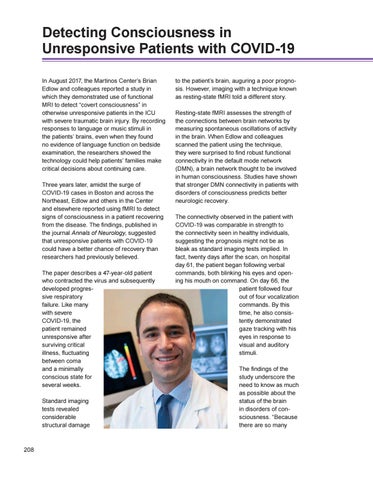Detecting Consciousness in Unresponsive Patients with COVID-19 In August 2017, the Martinos Center’s Brian Edlow and colleagues reported a study in which they demonstrated use of functional MRI to detect “covert consciousness” in otherwise unresponsive patients in the ICU with severe traumatic brain injury. By recording responses to language or music stimuli in the patients’ brains, even when they found no evidence of language function on bedside examination, the researchers showed the technology could help patients’ families make critical decisions about continuing care. Three years later, amidst the surge of COVID-19 cases in Boston and across the Northeast, Edlow and others in the Center and elsewhere reported using fMRI to detect signs of consciousness in a patient recovering from the disease. The findings, published in the journal Annals of Neurology, suggested that unresponsive patients with COVID-19 could have a better chance of recovery than researchers had previously believed. The paper describes a 47-year-old patient who contracted the virus and subsequently developed progressive respiratory failure. Like many with severe COVID-19, the patient remained unresponsive after surviving critical illness, fluctuating between coma and a minimally conscious state for several weeks. Standard imaging tests revealed considerable structural damage
208
to the patient’s brain, auguring a poor prognosis. However, imaging with a technique known as resting-state fMRI told a different story. Resting-state fMRI assesses the strength of the connections between brain networks by measuring spontaneous oscillations of activity in the brain. When Edlow and colleagues scanned the patient using the technique, they were surprised to find robust functional connectivity in the default mode network (DMN), a brain network thought to be involved in human consciousness. Studies have shown that stronger DMN connectivity in patients with disorders of consciousness predicts better neurologic recovery. The connectivity observed in the patient with COVID-19 was comparable in strength to the connectivity seen in healthy individuals, suggesting the prognosis might not be as bleak as standard imaging tests implied. In fact, twenty days after the scan, on hospital day 61, the patient began following verbal commands, both blinking his eyes and opening his mouth on command. On day 66, the patient followed four out of four vocalization commands. By this time, he also consistently demonstrated gaze tracking with his eyes in response to visual and auditory stimuli. The findings of the study underscore the need to know as much as possible about the status of the brain in disorders of consciousness. “Because there are so many
